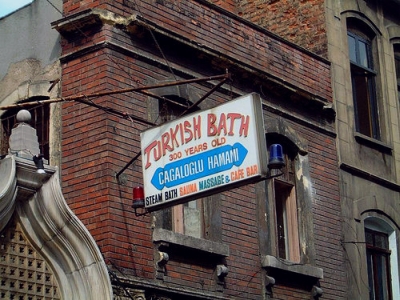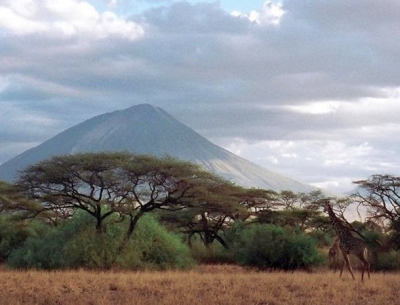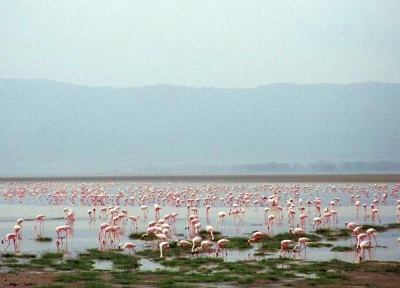The post Fear And Bathing In Istanbul appeared first on The Expeditioner Travel Site.
]]>Seeking a true cultural experience, Cameron immerses himself in some uniquely Turkish hospitality in Istanbul.
Face down on the cool, smooth marble slab, I lay hot, sweating and uncomfortable. The air’s humidity has formed into huge balls of condensation which plummet from the domed ceiling high above. When the drops don’t hammer directly onto my head and body, they bombard the slab all around, showering me with tiny staccato splashes. In a desperate attempt to adjust to the heat, my pores open and emit a seemingly endless supply of moisture.
I am alone, and virtually naked. Out of my depth. Unsure of protocol, I shift uncomfortably in the gathered pond of condensation and sweat — and wait. I sense movement around me. At first it is near my feet where they dangle over the rounded edge of the slab, and then alongside my hips, body, then shoulder. Just as I expect it to make contact, the presence retreats. I am tense, alarmed, but not yet scared. But I am absolutely out of my comfort zone. I am out of my comfort horizon. Out of my comfort hemisphere.
To find some sense in the uncertainty I recall all that I know for sure: I am partially covered, but not clothed. I am lying on a marble slab, with my body giving up the last of its essence. I feel abandoned, but a presence lurks just out of reach. My verdict: I am dead. The adventure ends here. Without a fight, without a whimper. But other factors conspire to contradict this conclusion: I am not cold — as I would expect to be in death — but in a warm place. My body does not give up blood and excreta, it only offers sweat.
But as I begin to think that I may not yet have reached the end of my life, the presence returns, this time beside my head. The first words are deep, husky, and tobacco-stained: “I am here”.
Is this the voice of death? The gruffness, the nicotine, the impatience confirms what I’ve always suspected: that when I die, as I may yet have done on this day on this lonely marble slab, then I am not heading upwards to the guy with the long white beard. Because the voice in my ear is surely the voice of the other guy. The underlord. The devil himself.
Before surrendering to an afterlife of sweat and toil, of misery and labor, I awaken to recall my circumstances more clearly: the smell of diesel and the shisha pipe, the street noise of cars, carts and bartering, and the deep rumbling of Arabic-laced debate. I am far from hell. I am in Istanbul, near the Kapali Carsi, the Grand Bazaar. In a hamam — a Turkish bath house. And rather than being banished here to pay for my sins I came of my own free will — albeit nervously — for an authentic Turkish experience, and to escape the alma chai (apple tea) and hounding of the carpet sellers.
 Hamami are found in most major cities and towns in Turkey. While hamami in the city are larger and more elaborate than those in the smaller towns, all typically feature private, individual cubicles for dressing and undressing, with a central and communal bath house. The hamam in which I endure Hamid’s attention has a grand central chamber with an ivory-white, curved marble stage which easily accommodates more than 30 bodies.
Hamami are found in most major cities and towns in Turkey. While hamami in the city are larger and more elaborate than those in the smaller towns, all typically feature private, individual cubicles for dressing and undressing, with a central and communal bath house. The hamam in which I endure Hamid’s attention has a grand central chamber with an ivory-white, curved marble stage which easily accommodates more than 30 bodies.
When seeking out a venue for this experience, I had sought the guidance from the manager of my hostel who strongly advised that I visit a “tourist” hamam. Uncomfortable with further questioning on the subject, he simply re-iterated: “For tourist, only. Please.” Perhaps the “tourist” masseuses spoke English (clearly not), or perhaps they provided an abbreviated and less vigorous version of a traditional Turkish bath. I can only wonder what the traditional service entailed.
Relieved that my end is not yet at hand, I relax back into the puddle of condensation and sweat, breathing in the hot, retching stench of dozens of perspiring bodies. Brilliant white light streams through the star-shaped holes in the domed ceiling, illuminating the strange, exotic chamber of maleness around me.
The voice of death turns out to be Hamid, my appointed masseuse, who’s English is on a par with my Turkish, which is to say next to zero. Our conversation is sparse. Even if we’d had a shared language I wonder how we’d ever find anything at all suitable to discuss in this odd situation: a large, dark, hairy, Turkish man, scrubbing from head to toe a somewhat anxious (but fast becoming very clean) blonde Australian wearing only a small piece of patterned cloth and nervous smile.
Called a pesternal, the cloth wraps around my waist with less than an inch overlapping — making any form of fastening marginal — and extends barely beyond my now trembling buttocks. The cloth is a futile effort at dignity, and Hamid appears to be wholly ignorant of its purpose as he works around, over and underneath it. The pesternal is a largely redundant adornment and affords little modesty in the bath house. Despite the texture and atmosphere that it might add to this story, the sight of dozens of sweaty men, each wrapped in a virtual handkerchief, is one best left undescribed. But for the curious, be satisfied with this: the hamam is full of men of all shapes, sizes and fitness, in various stages of bathing, absolutely unconcerned about the sights they display when bending or sitting carelessly.
“I am Hamid. Ha-Meed,” he repeats slowly. I am only slightly comforted by his attempt at formalities, and remain in what I feel to be a very vulnerable situation. Aside from a guidebook explanation, I have little idea of what a traditional Turkish bath actually entails. Hamid’s next words push me over the crest of fear, into the abyss of panic. “I give you special service.”
I am terrified. I am defenseless. I do not understand. What exactly does “special service” mean? I lay there and nurse myself back into the now warm, safe idea that maybe I am dead after all.
Over the next half-hour Hamid — bare-chested, his own pesternal giving only partial coverage to his ample girth and undercarriage — washes, scrubs, and rinses my body with warm water that he collects in a plastic bucket. The temperature in the hamam has risen and condensation runs like a river down the concrete walls, drips off the ornate windows, gathers in the cracks in the floor, and drains away.
Scraping along my forearm with a short plastic tool that resembles a small ruler, Hamid holds up before my eyes a dark brown sludge that had until now resided merrily undetected in my pores, resistant to the more conventional washing arrangements of soap and hot water. Squirting shampoo from his small pink tube onto my head, Hamid proceeds to give my hair a vigorous and thorough wash. With my hands over my eyes, the warm water running over my face, I regress to infancy, Hamid replaced by an over-zealous grandmother with an obsession for clean children.
To describe the experience in full would be to lift the veil and remove the mystique of this most exotic experience. It is simply one of those times when you must suspend disbelief and discomfort and plunge in to find where the real cultural flavor resides.
Having survived the hamam I emerge back into the chaos of the street considering the idea that it is only by confronting fear — and potentially the devil himself — that we feel truly alive. After months on the road, the bath has provided a feeling of renewal and rejuvenation. I feel cleaner than ever before and am convinced that Hamid’s efforts have actually removed a number of freckles. The hamam is a revitalizing exercise, a confronting and potentially terrifying experience, and uniquely Turkish. And all for $30. Oh, and another $10, as a tip, for the “special service.” Whatever that was.

The post Fear And Bathing In Istanbul appeared first on The Expeditioner Travel Site.
]]>The post Conquering Tanzania’s Mountain Of God appeared first on The Expeditioner Travel Site.
]]>
Many of Africa’s greatest adventures lie well away from the main tourist trails. Cameron Fergus climbs Oldoinyo Lengai in Tanzania for a new perspective on God and man.
By Cameron Fergus
“It’s a volcano, as long as we keep going up we’ll be fine.” My girlfriend’s plan to abandon our guide, though ambitious, was also probably a little too impulsive. Here we were, in the pitch-black African night, halfway up an active volcano in Tanzania, surrounded by thick fog in an area frequented by leopards, and our guide was fast asleep at our feet. Okuni, our brave Maasai warrior, experienced mountain guide, and only hope of scaling the volcano, possessed the enviable ability to fall instantly and deeply asleep. It was time for a decision. Try again to wake our slumbering leader or push on alone.
We had come to this rugged corner of northern Tanzania to climb Oldoinyo Lengai, an ancient volcano known to the Maasai tribe as the “Mountain of God.” The volcano was precisely the off-the-beaten-track destination we were looking for. A picture-perfect volcano emerging almost 10,000 feet from the surrounding plains, it epitomized remoteness, and, let’s face it, climbing the Mountain of God just sounded epic.
Our drive to the volcano — often simply referred to as “Lengai” — from the town of Arusha followed a collection of roads, tracks, and goat trails that are typical of East Africa. The drive was interrupted twice, both times in a uniquely African manner: a giraffe munching on an Acacia tree in the middle of the road, and an opportunity to take a close-up photo of a lion sleeping in the shade. Finally, after a long, hot, and dust-blown adventure we arrived at the shore of Lake Natron in the late afternoon.
 Lake Natron sits 25 kilometers north of Lengai and is a wonder in its own right. With the sun retreating behind the surrounding hills and the sweeping dance of the flamingos playing out before us, our position on the lakeshore was a quiet, peaceful, and stunning place to be. The energy-sapping heat of the day had passed and the cooling breeze off of the lake was a welcome relief. The only sounds in the world were the clacking of the pink and white beauties on the lake and our feet crunching the salt-encrusted shores as we raced the quickly fading light to catch the spectacle. We were honored to have the performance to ourselves, and buoyed by the fact that the interactions of life in Africa’s wild continues to play out each day regardless of the existence (or size) of an audience.
Lake Natron sits 25 kilometers north of Lengai and is a wonder in its own right. With the sun retreating behind the surrounding hills and the sweeping dance of the flamingos playing out before us, our position on the lakeshore was a quiet, peaceful, and stunning place to be. The energy-sapping heat of the day had passed and the cooling breeze off of the lake was a welcome relief. The only sounds in the world were the clacking of the pink and white beauties on the lake and our feet crunching the salt-encrusted shores as we raced the quickly fading light to catch the spectacle. We were honored to have the performance to ourselves, and buoyed by the fact that the interactions of life in Africa’s wild continues to play out each day regardless of the existence (or size) of an audience.
The serenity of the lake was offset by Lengai’s massive form, looming over our shoulders as a reminder of our night’s planned activities. “Lengai is a wall,” laughed David, our driver, guide and entertainer, “and I am glad I won’t be climbing it. I have organized for a local Maasai to take you to his God.” Our mountain guide, the softly and infrequently spoken Okuni, later assured us that the Maasai god “Ngai” was generally a welcoming host, with only infrequent demonstrations of his eruptive might. And yes, according to Okuni, somewhat baffled at being asked such an apparently obvious question, Ngai was, of course, a man.
Ascending Lengai requires a midnight start in order to avoid the scorching heat of the Crater Highlands during the day. The seven to nine hour round trip (four to six hour ascent, three hour descent) requires no technical climbing prowess, just determination and a sense of humor as you will slip repeatedly on the crumbling, powdery slopes. Due to the largely unmarked and apparently random routes up the mountain, an experienced guide is essential.
But what to do about our brave Maasai guide, halfway up the mountain of his god, asleep amidst the rubble of the last eruption? Despite previous attempts at calling his name (meaning “three’”in Maasai, signifying his place in the family behind his older siblings), and hurling small rocks down the mountain, Okuni was not to be disturbed. Following yet another suspicious sound — this time the unmistakable thud of heavy paws landing on rock emanating from just beyond the fog — a well meaning nudge was administered to Okuni’s leg, awakening our guide with a start.
The major challenge in climbing Lengai (aside from keeping your guide awake) is navigating the crumbling channels created by the lava flows which, in turn, give way to increasingly steep and slippery rock faces. Whilst Lengai’s last major eruption was in 1966, its active status has been maintained through a series of significant but smaller eruptions, the most recent reported throughout 2008. The lava flows, powdery slopes, and pungent stench of sulfur were evidence to us that while (like our guide) Lengai is frequently sleeping, it is certainly not finished its active life just yet. For many hours we climbed in and out of the gullies formed by Lengai’s eruptions, slipping (repeatedly) and cursing ourselves (frequently).
The arrival of rain around 4 a.m. did nothing to help elevate our position on the mountain or our morale. On the bright side, the unseasonable rain would “keep away the leopards” according to Okuni, breaking the silence he’d maintained for the past two hours.
The summit of Lengai appeared as the rain began to let up and the sun lightened the sky to the east. Our toil throughout the night had delivered us to a crater which was covered in an impenetrable, sulfuric fog, seemingly an inadequate reward for all our efforts. Denied the sunrise vista at the summit, our descent featured perhaps the most startling panorama of the trek. The surrounding hills, painted green and grey behind the retreating mists, was the unanticipated treat that bolstered our spirits for the return journey.
The steep slopes of the mountain were no easier to negotiate on the way down than they were on the way up, but the early morning light revealed just how this volcano truly towers over the surrounding landscape. Lake Natron in the distance was covered in a fine mist, with no sign of the congregation of flamingos from the previous day. Despite the beauty of the views, we returned to the base of the mountain exhausted and a little dejected. Our difficulties on the mountain must have been evident as David, who had driven from camp to collect us, simply reaffirmed “I told you Lengai is a wall.”
For days after I was disappointed about Lengai. I had felt deflated after all the effort and expectation. I had imagined a scorching heat emanating from a wildly bubbling crater and a 360-degree view of Lengai’s surrounds, but we had climbed throughout the night to find a summit clouded by fog.
But as I thought about it more, perhaps therein lies the lesson. The places we visit owe us nothing. They were not created over millions of years so that we could have a great set of photos to take home. Other climbers have reported looking deep into Lengai’s gurgling crater and of spectacular views from the summit right across the plains to Mount Kilimanjaro. But all is forgiven. I now look at Lengai, a picture of exactly what a volcano should look like, and send up a prayer to Ngai to welcome and reveal his inexorable charms to all of those souls willing to venture off of that well-beaten path. And to please keep his Maasai faithful awake, there are leopards out there . . .

Cameron, in lieu of payment for this piece, has agreed to make a donation in the amount of $40 to WaterAid, an organization working to support clean water efforts in Tanzania.
You can do the same. Click here to make an online donation to WaterAid.
The post Conquering Tanzania’s Mountain Of God appeared first on The Expeditioner Travel Site.
]]>